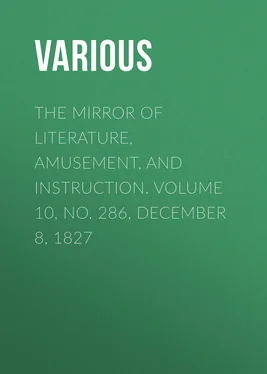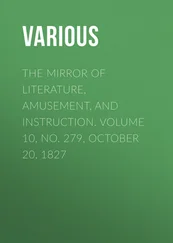Various - The Mirror of Literature, Amusement, and Instruction. Volume 10, No. 286, December 8, 1827
Здесь есть возможность читать онлайн «Various - The Mirror of Literature, Amusement, and Instruction. Volume 10, No. 286, December 8, 1827» — ознакомительный отрывок электронной книги совершенно бесплатно, а после прочтения отрывка купить полную версию. В некоторых случаях можно слушать аудио, скачать через торрент в формате fb2 и присутствует краткое содержание. Жанр: foreign_antique, periodic, Развлечения, foreign_edu, на английском языке. Описание произведения, (предисловие) а так же отзывы посетителей доступны на портале библиотеки ЛибКат.
- Название:The Mirror of Literature, Amusement, and Instruction. Volume 10, No. 286, December 8, 1827
- Автор:
- Жанр:
- Год:неизвестен
- ISBN:нет данных
- Рейтинг книги:5 / 5. Голосов: 1
-
Избранное:Добавить в избранное
- Отзывы:
-
Ваша оценка:
- 100
- 1
- 2
- 3
- 4
- 5
The Mirror of Literature, Amusement, and Instruction. Volume 10, No. 286, December 8, 1827: краткое содержание, описание и аннотация
Предлагаем к чтению аннотацию, описание, краткое содержание или предисловие (зависит от того, что написал сам автор книги «The Mirror of Literature, Amusement, and Instruction. Volume 10, No. 286, December 8, 1827»). Если вы не нашли необходимую информацию о книге — напишите в комментариях, мы постараемся отыскать её.
The Mirror of Literature, Amusement, and Instruction. Volume 10, No. 286, December 8, 1827 — читать онлайн ознакомительный отрывок
Ниже представлен текст книги, разбитый по страницам. Система сохранения места последней прочитанной страницы, позволяет с удобством читать онлайн бесплатно книгу «The Mirror of Literature, Amusement, and Instruction. Volume 10, No. 286, December 8, 1827», без необходимости каждый раз заново искать на чём Вы остановились. Поставьте закладку, и сможете в любой момент перейти на страницу, на которой закончили чтение.
Интервал:
Закладка:
DANGER
Like some lone Pilgrim in the dusky night,
Seeking, through unknown paths, his doubtful way,
While thick nocturnal vapours veil his sight
From yawning chasms, that 'neath his footsteps lay;
Sudden before him gleams the forked light!
Dispels the gloom, yet fills him with dismay.
His trembling steps he then retraces back,
And seeks again the well-known beaten track.
CATS
The first couple of these animals which were carried to Cuyaba sold for a pound of gold. There was a plague of rats in the settlement, and they were purchased as a speculation, which proved an excellent one. Their first kittens produced thirty oilavas each; the new generation were worth twenty; and the price gradually fell as the inhabitants were stocked with these beautiful and useful creatures. Montengro presented to the elder Almagro the first cat which was brought to South America, and was rewarded for it with six hundred pesos .
THE DEATH OF KING JOHN
In the yeere 1216, king John was poisoned, as most writers testify, at Swinsted Abbey, by a monk of that abbey, of the order of Cistersians, or S. Bernard's brethren, called Simon of Swinsted. The monk did first consult with his abbot, shewing him what he minded to do, alleging for himself the prophecy of Caiphas, 11th of John, saying, it is better that one man die, than the whole people perish. I am well content, saith he, to lose my life, and so become a martyr, that I may utterly destroy this tyrant. With that the abbot did weep for gladness, and much commended his fervent zeal. The monk then being absolved of his abbot for doing this fact, went secretly into the garden, on the back side, and finding there a most venomous toad, did so prick him and press him with his penknife, that hee made him vomite all the poison that was within him; this done, he conveyed it into a cup of wine, and with a flattering and smiling countenance he sayeth to the king, "If it shall please your princely majesty, here is such a cup of wine as you never drank better in your lifetime. I trust this wassall shall make all England glad," and with that he drank a great draught thereof, and the king pledged him; the monk then went out of the house to the back, and then died, his bowels gushing out of his belly, and had continually from henceforth three monks to sing mass for him, confirmed by their general charter. The king, within a short space after, feeling great grief in his body, asked for Simon, the monk; answer was made he was dead. "Then God have mercy on me," said the king; so went he to Newark-upon-Trent, and there died, and was buried in the cathedral church at Worster, in 1216, the 19th day of October, after having been much fered with the clergy 18 years, 6 months, and a day.
MALVINA.LILLIARD EDGE
Near the border between the parishes of Maxton and Ancrum is a bridge, called Lilliard Edge, formerly Anerum moor, where a battle was fought between the Scots and English soon after the death of king James V., who died in the year 1542. When the Earl of Arran was regent of Scotland, Sir Ralph Rivers and Sir Bryan Laiton came to Jedburgh with an army of 5,000 English to seize Merse and Teviotdale in the name of Henry VIII., then king of England, who died not long after, in the year 1547. The regent and the Earl of Angus came with a small body of men to oppose them. The Earl of Angus was greatly exasperated against the English, because some time before they had defaced the tombs of his ancestors at Melrose, and had done much hurt to the abbey there. The regent and the Earl of Angus, without waiting the arrival of a greater force, which was expected, met the English at Lilliard Edge, where the Scots obtained a great victory, considering the inequality of their number. A young woman of the name of Lilliard fought along with the Scots with great courage; she fell in the battle, and a tombstone was erected upon her grave on the field where it was fought. Some remains of this tombstone are still to be seen. It is said to have contained the following inscription:—
"Fair maiden Lilliard lies under this stane;
Little was her stature, but great was her fame.
On the English lads she laid many thumps,
And when her legs were off she fought on her stumps."
BOOKS AND BOOKWORMS
Books were anciently made of plates of copper and lead, the bark of trees, bricks, Stones, and wood. Josephus speaks of two columns, the one of stone, the other of brick, on which the children of Seth wrote their inventions and astronomical discoveries. Porphyry mentions some pillars, preserved in Crete, on which the ceremonies observed by the Corybantes in their sacrifices were recorded. The leaves of the palm-tree were used, and the finest and thinnest part of the bark of such trees as the lime, the ash, the maple, and the elm; from hence comes the word liber , which signifies the inner bark of the trees; and as these barks are rolled up, in order to be removed with greater ease, these rolls were called volumen , a volume, a name afterwards given to the like rolls of paper or parchment. By degrees wax, then leather, were introduced, especially the skins of goats and sheep, of which at length parchment was prepared; also linen, then silk, horn, and lastly paper. The rolls or volumes of the ancients were composed of several sheets, fastened to each other, rolled upon a stick, and were sometimes fifty feet in length, and about a yard and a half wide. At first the letters were only divided into lines, then into separate words, which, by degrees, were noted with accents, and distributed by points, and stops into periods, paragraphs, chapters, and other divisions. In some countries, as among the orientals, the lines began from the right, and ran to the left; in others, as in northern and western nations, from the left to the right; others, as the Grecians, followed both directions alternately, going in the one and returning in the other.
In the Chinese books, the lines run from top to bottom. Again, the page in some is entire and uniform; in others, divided into columns; in others, distinguished into text and notes, either marginal or at the bottom; usually it is furnished with signatures and catch-words, also with a register to discover whether the book be complete. The Mahometans place the name of God at the beginning of all their books. The word book is derived from the Saxon boc , which comes from the northern buech , of buechans , a beech, or service-tree , on the bark of which our ancestors used to write. A very large estate was given for one on Cosmography by king Alfred. About the year 1400, they were sold from 10 l . to 30 l . a piece. The first printed one was the Vulgate edition of the Bible, 1462; the second was Cicero de Officiis , 1466. Leo I. ordered 200,000 to be burnt at Constantinople. In the suppressed monasteries of France, in 1790, there were found 4,104,412 volumes; nearly one-half were on theology. The end of the book, now denoted by finis , was anciently marked with a <, called coronis , and the whole frequently washed with an oil drawn from cedar, or citron chips strewed between the leaves, to preserve it from rotting.
Читать дальшеИнтервал:
Закладка:
Похожие книги на «The Mirror of Literature, Amusement, and Instruction. Volume 10, No. 286, December 8, 1827»
Представляем Вашему вниманию похожие книги на «The Mirror of Literature, Amusement, and Instruction. Volume 10, No. 286, December 8, 1827» списком для выбора. Мы отобрали схожую по названию и смыслу литературу в надежде предоставить читателям больше вариантов отыскать новые, интересные, ещё непрочитанные произведения.
Обсуждение, отзывы о книге «The Mirror of Literature, Amusement, and Instruction. Volume 10, No. 286, December 8, 1827» и просто собственные мнения читателей. Оставьте ваши комментарии, напишите, что Вы думаете о произведении, его смысле или главных героях. Укажите что конкретно понравилось, а что нет, и почему Вы так считаете.











